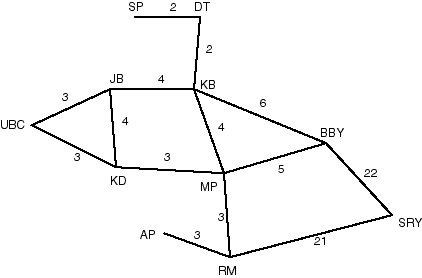


Go backward to Question 1
[15 marks]
Go up to Top
Go forward to Question 3(a)
Question 2 [15 marks]
Consider the graph (not drawn to scale) with arc lengths shown on the arcs:

Suppose we have the following heuristic
values for the distance to sp.
|
h(sp)=0 | h(dt)=2 | h(kb)=3 |
|
h(jb)=3 | h(ubc)=5 | h(kd)=6 |
|
h(mp)=7 | h(bby)=8 | h(ap)=8 |
|
h(rm)=9 | h(sry)=29
|
- (a)
- [6 marks] Show the nodes expanded (taken off the frontier), in
order, and the f-value for each node added to the frontier for an A* search
from ubc to sp. Assume that multiple-path pruning is used, and
that the search stops after the first path
is found. Show clearly the path found.
[You can either number the nodes on the graph and give
the f-values, or use the space below to write your answer.]
- (b)
- [6 marks]
Show how dynamic programming can be used to find a path from ubc to
sp. Show all distance values that are computed, and how these are
used to find the shortest path. What path is found?
[You may use the graph to show your
answer, or write your answer in the space below, but you must explain
clearly what your notation means.]
- (c)
- [3 marks]
Suppose you were contacted by TecnoTaxi to advise on a method for
finding routes between locations in Vancouver. What method would you
recommend, and why. Give one shortcoming of the method you propose.
You must use full sentences.




